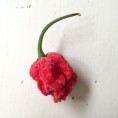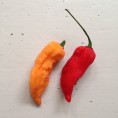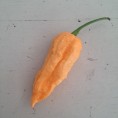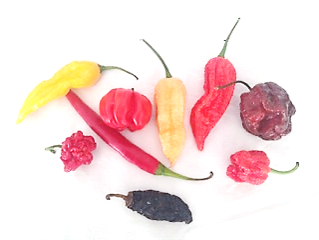
Hotonomy is the discipline, study and practice, of ridiculously hot stuff and finding ways to approach and deal with it. The pepper galaxy is the primary field of exploration of this dangerous but rewarding discipline. The chemical core of this galaxy is Heatrium, a.k.a. Capsaicin or Capsicum (the terms hotonomy and heatrium may be new to you, since we from The Heatory coined them). Important basics of hotonomy to understand are:
- Peppers: which are the popular innocent and conversely most dangerous ones
- Heatrium a.k.a. capsicum: what is it that causes this delighting agony
- Scoville: how to measure hotness, as to compare the one to the other
An important fourth item to dig and develop is: what to actually DO with this freaking heat (advanced hotonomy), to which we have our own range of answers.

Carolina Reaper

Trinidad Scorpion Butch Taylor

Ghost Pepper

Fatalii Pepper
Peppers are delicious, but more elementary, they are hot. Scientists prefer the word pungency over hotness, because “hot” is ambiguous, and they like more difficult words that nobody else uses anyway. So what is it that peppers make you feel like you’re on fire? It is their chemical compound capsaicin, that activates heat receptors in your nerve endings. As a response to pain, your mouth goes numb when it gets into contact with mild peppers. The receptors in your mouth send a signal to your brain, telling it that it came across something hot, so your brain starts producing endorphines to ease your pain.
But even your powerful brain isn’t ready for the peppers on top of the list, mere numbness doesn’t cut it. Your body then steps in by creating blisters in your oral cavity, they are supposed to absorb the heat for you. This all sounds, uhm, great, but unfortunately when you eat an entire Carolina Reaper for example, even blisters can’t protect you from capsaicin attacking your mouth and tongue causing an enormous burning sensation. What’s the good news you ask? Well, your mouth returns to normal after a day or so. You can also try drinking lots of dairy, as this contains casein which neutralizes the capcaisin. More in general, drinks with fat or alcohol help dissolve the heat.
We get it if you wouldn’t feel like eating an entire Carolina Reaper or Trinidad Scorpion, but in advanced hotonomy, we create ways to actually enjoy capsaicin, or in our own terms, heatrium!
Fun fact: many birds are immune to capsaicin, since they simply do not have the corresponding taste receptors.
In 1912 Wilbur Scoville, an American chemist, delevoped a method to rate the heat a chili pepper can produce. The Scoville scale is the measurement of the pungency/heat of peppers. It’s reported in so called Scoville Heat Units (SHU’s). Basically you are measuring the concentration of capsaicin. The more units, the hotter your pepper. A couple of peppers have had their glory moment in the Guiness Book of Records. Carolina Reaper is currently the hottest. Only pepper spray and pure capsaicin are (much) hotter.

Pepper Spray: 2,000,000 – 5,300,000
Carolina Reaper: 1,600,000 – 2,200,000
Trinidad Scorpion: 1,200,000 – 2,000,000
Ghost Pepper (Jolokia): 850,000 – 1,100,000
Fatalii Pepper: 125,000 – 400,000
Madame Jeanette / Habanero Chili: 100,000 – 350,000
Tabasco Pepper: 30,000 – 50,000
Jalapeño: 2,500 – 8,000
Bell Pepper: 0



